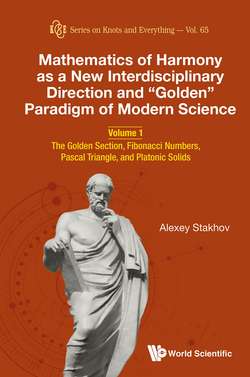Читать книгу Mathematics of Harmony as a New Interdisciplinary Direction and “Golden” Paradigm of Modern Science - Alexey Stakhov - Страница 6
На сайте Литреса книга снята с продажи.
Contents
ОглавлениеPreface to the Three-Volume Book
Introduction
About the Author
Acknowledgments
Chapter 1. The Golden Section: History and Applications
1.1 The Idea of the Universeal Harmony in Ancient Greek Science
1.2 The Golden Section in Euclid’s Elements
1.3 Proclus Hypothesis and New View on Classic Mathematics and Mathematics of Harmony
1.4 Some Simplest Mathematical Properties of the Golden Ratio
1.5 The Golden Ratio and Chain Fractions
1.6 Equations of the Golden Proportion of the Nth Degree
1.7 Geometric Figures Associated with the Golden Section
1.8 The Golden Section in Nature
1.9 The Golden Section in Cheops Pyramid
1.10 The Golden Section in Ancient Greek Culture
1.11 Golden Section in the Art of the Renaissance
Chapter 2. Fibonacci and Lucas Numbers
2.1 A History of the Fibonacci Numbers
2.2 The Sums of the Consecutive Fibonacci Numbers
2.3 Cassini’s Formula
2.4 Lucas Numbers
2.5 Binet’s Formulas
2.6 Steinhaus’s “Iron Table”
2.7 Pythagorean Triangles and Their Presentation Through Fibonacci and Lucas Numbers
2.8 Fibonacci Numbers in Nature
2.9 Fibonacci Numbers and Solution of Hilbert 10th Problem
2.10 Turing and Fibonacci Numbers
2.11 Role of the Fibonacci Numbers Theory in Modern Mathematics
Chapter 3. Pascal Triangle, Fibonacci p-Numbers and Golden p-Proportions
3.1 Binomial Theorem
3.2 Pascal Triangle
3.3 Diagonal Sums of Pascal’s Triangle and Fibonacci p-Numbers
3.4 The Extended Fibonacci p-Numbers
3.5 Generalization of the Golden Section Problem
3.6 Algebraic Equations for the Golden p-Proportion and Vieta’s Formulas
3.7 Binet’s Formulas for the Fibonacci p-Numbers
3.8 Binet’s Formulas for the Lucas p-Numbers
Chapter 4. Platonic Solids: From Plato’s Cosmology to Fullerenes and Quasicrystals
4.1 The Golden Section in Platonic Solids
4.2 Archimedean Truncated Icosahedron and Stellate Polyhedra
4.3 The Mystery of the Egyptian Calendar
4.4 Dodecahedral–Icosahedral Doctrine
4.5 Johannes Kepler: From “Mystery” to “Harmony”
4.6 Icosahedron as the Main Geometric Object of Mathematics
4.7 Usage of the Regular Polyhedra in the Fine Art
4.8 Dan Shechtman’s Quasicrystals
4.9 Fullerenes
4.10 Platonic Solids and New Ideas in the Theory of Elementary Particles
Conclusions
Bibliography
